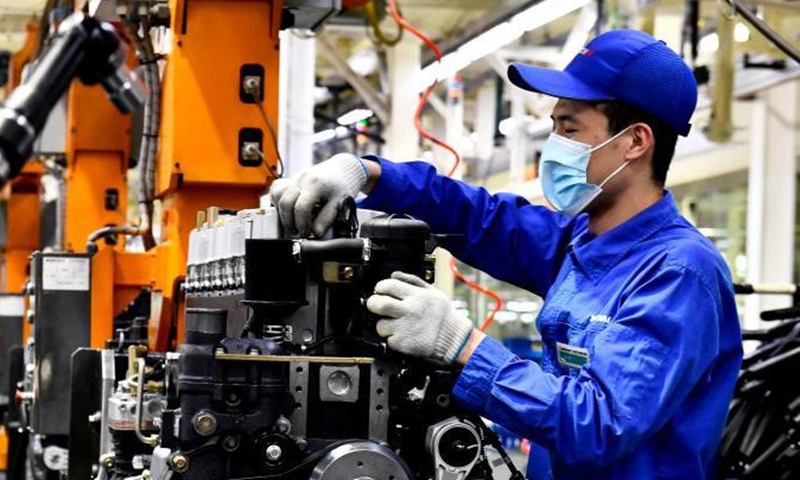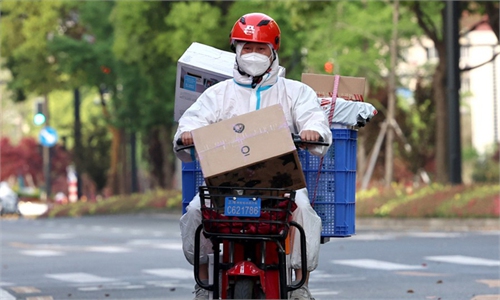
Photo:Xinhua
China's April industrial production contracted by 2.9 percent year-on-year, while retail sales were down 11.1 percent, as the effects of Omicron flare-ups' disruptions on the economy further deteriorated. However, the National Bureau of Statistics (NBS) said there are signs of improvement in May and growth in the second quarter is expected to remain stable.
Analysts have claimed that as a recovery gains pace in June, the second quarter may see the economy grow by 4.8 percent, the same level as that of the first quarter, paving the way for annual growth target of around 5.5 percent.
Industrial production contracted by 2.9 percent in April, down from a growth of 5 percent in March and retail sales shrank by more than 11 percent, according to the NBS. Both figures were lower than market expectations, reflecting epidemic's weight on the economy.
Fixed-asset investment saw a year-on-year increase of 6.8 percent to 15.4 trillion yuan ($2.27 trillion), down 2.5 percentage points compared with the first quarter due to the impact of Omicron.
However, despite the epidemic dealing a blow to the economy in April, the effects are "temporary and external," and Chinese economy's fundamentals remain positive and the trend of high-quality development remains unchanged, according to Fu Linghui, spokesperson for the NBS.
Fu said as the weather warms up, and the domestic COVID situation comes under control, the economy is expected to see improved performance.
Shanghai and Jilin were already in the process of resuming work and production and putting economic activity back on track, Fu said.
Economy to continue to grow in Q2
When asked about the risk of the economy plunging into negative territory, Fu said China's economy is still expected to achieve "relatively sound" growth in the second quarter, as measures have been taken to support investment and the manufacturing sector, while consumption will gradually recover during the quarter to drive stable economic growth.
Fu said investment, consumption and exports, three components of the GDP figure, will all record growth in the next phase.
Cao Heping, an economist from Peking University, told the Global Times on Monday that the poor data in April reflected the drag caused by the epidemic, which was already shown in March and became more serious in April.
The epidemic's impact on Hong Kong and Shanghai as well as a large spillover was clear to see, as the two most dynamic economic regions in China, the Pearl River Delta and the Yangtze River Delta, were impacted, Cao said, noting the impact was carried over into May.
Cao said the dual impacts meant that the downward pressure China faced in April is the most serious challenge since the first quarter of 2020, when the COVID-19 outbreak first hit Wuhan, Central China's Hubei Province.
Liao Qun, chief economist with Chongyang Institute for Financial Studies at Renmin University of China, said although the epidemic has negatively affected industrial production, consumption and investment, high-tech sectors bucked the trend by posting a growth of 4 percent, showing the resilience of a vital sector important to China's economic future.
Liao said as Shanghai as well as a number of other cities gradually walked out of static management, the national economy will also regain some lost ground.
"It seems that May data will be definitely better than April's, so the question to ask is whether May will be much than March," Liao said, who remained cautious believing a 4.8-percent growth for the second half would need to be hard fought.
In March, industrial production grew by 5 percent while retail sales contracted by 3.5 percent. Growth in fixed-asset investment was 9.3 percent in the first three months of 2022, slowing down from a 12.2-percent jump in January-February period.
Since April, Chinese economy was faced with "unprecedented downward headwinds since the first quarter of 2020" due to COVID-19 flareups, supply chain snags and external uncertainties arising from the Russia-Ukraine conflict.
Vital localities for industrial production, including manufacturing hub Shanghai and Northeast China's Jilin Province, entered "static management" to combat COVID-19 between March, stretching into April.
As Shanghai "paused" for the month, supply chains in the Yangtze River Delta - accounting for one-fourth of China's GDP - were also affected.
Cao said if the economy could gradually stage a rebound in June, national GDP could still reach around 4.8 percent in the second quarter, which means reaching the annual growth goal of percent still plausible on the back of serious efforts in the second half.
To that end, China will need more pro-growth monetary policies to be rolled out to produce synergy of an already working fiscal policy, Cao said.
Liao expects China to further loosen the ' reserve requirement ratio for banks by five more times this year, continue to lower the medium-term lending facility interest rate and partially lower borrowing costs.
He also suggested the deficit ratio could be matched up to over 3 percent, as the economic situation has markedly worsened since the drawing of the Government Work Report, which set the rate at around 2.8 percent.
"That will generate more fiscal support to the economy," Liao said.
China's GDP grew by 4.8 percent in the first quarter of 2022.
Global Times



